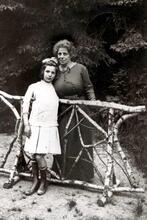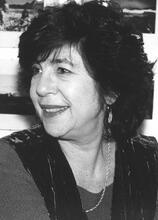Eleanor Antin
Eleanor Antin explored issues of gender, race, and identity by taking on personae of various outsiders in her performance art, installation art, and films. Some of Antin’s work has involved photographing and filming herself: first a series of nudes during drastic weight loss, then taking on other personae such as a surf king, a soap opera nurse, a black ballerina, Florence Nightingale, and a fictional Polish film director. Through these identities, Antin explored expectations and assumptions she and her audience had of race, gender, and societal roles. Antin was awarded both a Guggenheim and a National Endowment for the Arts Fellowship, and has been honored with two retrospectives of her work. She taught at the University of California in San Diego from 1975 to 2002.
“Impersonating the past, Antin personalizes the issues and dilemmas of the present. Her work is probably, more than we yet realize, a portrait of our time.”
This astute observation was decades ago by art critic Kim Levin in the catalogue for Eleanor Antin’s exhibition of The Angel of Mercy, held at the La Jolla Museum of Contemporary Art in California in 1977.
A seminal figure in the history of performance art, Eleanor Antin is one of the most prolific artists of the last several decades, moving freely in many forms of media, including live and installation art, independent film, photography, video, drawing, painting, and writing. Beginning as a Conceptual artist in the 1960s, Antin has played a formative role in the expansion of feminist art using non-traditional narrative forms, such as biography, autobiography, and alter-egos, or personas. Antin’s nomadic relation to these differing kinds of media has enabled her to explore the true issues and ideas which primarily engage her: explorations of self, gender, race, culture, and Jewish identity.
Early Life & Education
Born in the Bronx, New York, on February 27, 1935, Eleanor Fineman entered a world of leftist, Russian, Polish, Jewish intelligentsia, with a great love for Yiddish culture. Her parents had emigrated in the 1930s from Rush, a tiny town in Poland. Her father, Sol Fineman (né Peroshkia, 1910–2004), was a socialist and atheist who worked in the garment industry in New York. Her mother, Jeanette Efron (1912–1994), a former actress in the Yiddish theater in Poland and a communist in love with Russia, was a creative businesswoman and entrepreneur, who called herself Jeanette Fineman until she and Sol divorced. Antin’s sister, Marcia Goodman, was born on January 26, 1940.
Eleanor Fineman attended Music and Art High School in New York as an art major and City College of New York (CCNY), where she majored in writing and minored in art. From 1954 to 1956 she studied philosophy at the New School for Social Research and acting at the Tamara Daykarhonova School for the Stage. She was registered in Actors’ Equity and worked as an actress under the stage name Eleanor Barrett. In her last year of college she decided to quit school and take a job with a traveling road company as an actor in William Inge’s Bus Stop. During this period, 1955–1958, Antin worked briefly as an actress for Ossie Davis and supported herself modeling for painters Isabel Bishop (1902–1988), Moses Soyer (1899–1974), and husband and wife artists Jack Levine (b. 1915) and Ruth Gikow.
Early Art Career
Antin returned to CCNY (City College of New York) and received her B. A. in creative writing and art in 1958. Eleanor Fineman met David Antin when they were both students at CCNY. Born on February 1, 1932, David was a poet and writer who later became known in the art world as a critic. They married in 1961. Because Antin and her husband were so heavily involved in the art and literary scene in New York, David started writing art criticism for Tom Hess, the editor of Artnews, and Eleanor Antin began what she considers to be her first mature work as a Conceptual artist, Blood of a Poet Box, begun in 1965. Using a wooden slide box, Antin filled it with one hundred glass slides of blood specimens collected from one hundred poets she knew personally. The piece was made in homage to Jean Cocteau’s surrealistic film of 1930, Le Sang d’un Poète (“The Blood of a Poet”). It is an elegant example of Antin’s respect for art and life, her love for artists, and a play on the Romantic ideal of the inner artist as being a poetic, creative soul who gives no less than his lifeblood to make art. Among the poets are John Ashbery, John Cage, Allen Ginsberg, Lawrence Ferlinghetti, Jerome Rothenberg, and David Antin. It took Eleanor Antin three years (1965–1968) to complete this project. Her son, Blaise, born in 1967, was named after Blaise Cendrars, the modern French poet, novelist, and art critic. In 1968 Eleanor Antin, her husband David, and son Blaise moved from New York to Southern California, where David had been offered a faculty position teaching critical studies at the University of California in San Diego. Eleanor Antin taught at the University of California at Irvine (UCI) from 1974 to 1975, and then became a faculty member at the University of California in San Diego (UCSD) from 1975 to 2002.
100 Boots
“Conceptual art was opening up the possibility to cross mediums, cross genres, cross boundaries all over the place, to do something intelligent and fun, amusing, startling,” Antin recalls. In 1971 Antin devised 100 Boots, generally considered her best-known Conceptual work, a visual epic narrative created because she wanted an art work that lasted longer than the usual few weeks on exhibit in a New York gallery. She created a “mailwork,” using a mock picaresque novel in serial form (like Charles Dickens), which required a “hero,” who turned out to be one hundred black rubber gum boots, whom Antin refers to as “him” and “his” adventures. The 100 Boots were photographed by Philip Steinmetz as they traveled from California to New York, where their journey was presented in the summer of 1973 at the Museum of Modern Art as an exhibition of fifty-one black-and-white postcards mailed to one thousand art critics and other recipients around the world. Antin’s strikingly original concept completely bypasses the traditional gallery system of art distribution by using the postal system as a means of distribution. She is the first Conceptual artist to combine serial imagery and a fictional narrative content within a long-term art event spanning two and a half years.
Narrative Art
Deeply influenced by the feminist movement, Antin perceived that the range of Conceptual art should be expanded to include biography and narrative fantasy, both of which she had already begun to explore, plus autobiography, its interior or psychological explorations, as well as exterior representations and transformations. Antin realized she could use the fabric of her life, her fantasies and her own body as her medium. In 1972 Antin created Carving: A Traditional Sculpture, a grid installation of 144 black-and-white photographs taken of Antin’s nude body depicting her weight loss over a 36-day period of dieting which resulted in a loss of eleven and a half pounds. Antin’s body becomes a work in progress as she meticulously photographs herself daily from frontal, back and side views. At first glance it seems Antin is referencing the desire in our society for physical perfection and how women are always concerned with the need to improve their bodies. However, on closer examination, Antin raises deeper, more disturbing issues. She stands before us completely naked, the body of a white Jewish woman, at once a member of two oppressed minorities, one female, the other ethnic. The representation of the female nude is always prone to erotic interpretation, but in this work Antin presents her body as an impersonal object, subject to some type of classification system. Antin is very clear about her feelings of being and belonging. She has stated that even though American immigration has been so successful, as a Jew she is uncertain of her positioning and her feelings of safety. She states, “I’ve always felt like an outsider. In a sense I’m an exile, as a Jew. So as a Jew, I’m an outsider. As a woman, I’m an outsider.”
During the 1970s Antin started creating other selves, or personæ, through which she began to explore limitations of age, gender, race, class, and ethnicity. In 1972 Antin created the King, a benevolent monarch who is Antin in disguise, exploring her “male” and “political” selves, strolling through Antin’s surfing kingdom in Solana Beach, California. Antin realized she did not need to change her sex to become a man, only her gender, and would say later she found it easier to believe in, and act on, the American dream of self-invention living in San Diego than in New York. Antin’s second persona, the Ballerina, appears as a white ballerina who cannot really dance, and with characteristic deadpan humor Antin will say of her nameless icon, “I’m a terrific ballerina standing still.” Despite her limitations and lack of talent, the Ballerina is cast by Antin in a 1973 video installation Caught in the Act, which includes a series of photographs, Choreography I, II, and III, arranged in serial sequence like the photographs of Eadweard Muybridge. Antin’s third persona is a Nurse, who stars in Antin’s first feature-length movie, The Adventures of a Nurse, made in 1976, followed by The Nurse and the Hijackers, 1977. Antin relies on two American cultural genres, the soap opera and the adventure movie, to create these comic melodramas, but Antin’s true intention was to raise deeper questions about the subservience of women in modern American society and how stereotypes foster limited and prejudiced life models.
“I like to transform the past—the past is always being reinterpreted in light of the present.”
Later Artwork and Films
With this understanding, the fiction of history becomes a major new theme for Antin in The Angel of Mercy. The Nurse has been completely transformed into Eleanor Nightingale based on the real legendary nurse Florence Nightingale, often referred to as “The Angel of the Crimea.” Unlike her other performance selves, which were all portraits of the artist in disguise with their own fictive œuvres, for the first time Antin’s character is based on a true human being and on real history. Her performance piece, The Angel of Mercy, made in 1977, consists of two photo albums, The Nightingale Family Album and My Tour of Duty in the Crimea, sepia photographs mounted on handmade paper, showing Antin dressed like Florence Nightingale against the backdrop of the Crimean War, which was Victorian England’s Vietnam War and the first war in history to receive media coverage. Of the photos Antin says, “They weren’t brown in the nineteenth century. Brown is the color of romantic nostalgia.” She adds, “It is not the real thing which suggests the real in art. It is rather the slight disparity, the unexpected even, that will give the appearance of truth.”
Earlier in her career Antin had briefly explored being black in American society in the persona of the Black Movie Star, whom she retired but later transformed into Eleanora Antinova, Antin’s most famous persona. Antin says, “Antinova was my family, my childhood, my Eastern European roots, my childish passion for ballet and high culture.” Antinova is the celebrated, albeit fictive, Black Ballerina of Diaghilev’s Ballets Russes, who left her native United States for Paris to become a prima ballerina. She is the American black woman whom Diaghilev views as a “primitive,” the splendid black pearl he will cast in roles of dark, exotic passion, such as Cleopatra and the Queen of Sheba. Recollections of My Life with Diaghilev, 1919–1929 by Eleanora Antinova (and Eleanor Antin, 1981) is a portfolio of photographs, drawings, and reveries of her performances in The Prisoner of Persia, Before the Revolution, The Hebrews, Pocahontas, and L’Esclave. “I’m always creating these worlds for Antinova,” Antin said. Antinova became Antin’s favorite persona, the focus of her art in plays, performances, installations, silent films, photographs, drawings and memoirs from 1979 to 1989.
In the 1990s mortality became a major theme in Antin’s later films, due in part to her mother’s long-term illness, which affected Antin deeply. She states that when her mother was dying of Alzheimer’s, her English slipped away and her Yiddish—the language of her childhood—came back. Antin says, “As she forgot the stories and the language, I began to remember.” In 1991 Eleanor Antin took on the persona of a fictional Polish Jewish film director, Yevgeny Antinov, the director of The Man Without A World, a recently discovered “lost” film made by this forgotten Yiddish director in 1928. The story is an amalgam of many silent films, including The Dybbuk, a classic of the Jewish stage. In assuming the persona of Antinov and using the film as a historical artifact, Antin explores the doomed era of silent film history and the equally doomed world of Jewish shtetl life in Eastern Europe prior to World War II. Recalling the historical format of early silent films, the lost theatrical styles of Yiddish, and German expressionist cinema from the 1920s, Antin creates a simulation of a film which evokes a world of peoples and cultures that perished a long time ago, a world of ghosts. This Yiddish silent film was intended as a love letter to her mother.
Antin’s next film, Vilna Nights (1993), is a filmic installation consisting of a stage set and three rear-screen video projections representing the ruins of the Jewish ghetto in Vilna, the capital city of Lithuania. Here Antin explicitly explores motifs of Eastern European Jews during World War II and the specter of mass destruction. In this work Antin opens three windows in bombed-out buildings, surrounded by rubble, through which, as Antin says, we view “the ghosts of the vanished inhabitants as they continue to live out their interrupted lives.” Each vignette shows the three stages of life and places these ghosts of loss in Vilna, once home to the largest population of Jews in Europe, all but exterminated by Germany during World War II.
Following Vilna Nights, Antin made two more narrative films about loss, art, and artifice. In Minetta Lane: A Ghost Story (1995), Antin returns to the bohemian life she led in New York, “the old Greenwich Village culture I grew up in when I was a young girl.” “Little Miriam” is the star of this ghost story, a kind of poltergeist or imp, a nasty trickster who destroys a female painter’s abstract composition, causes malicious mischief for two lovers and is responsible for the death of an old man. Antin’s next film, Music Lessons (1997), her first collaboration with her husband, is a bittersweet fantasy on the pursuit of art and the fatal attraction of entering a world which appears full of beauty but in reality offers only despair and heartbreak.
Over the past several decades Eleanor Antin has put narrative into art content and widened the scope of our imaginative lives. In the exhibition catalogue, Eleanor Antin, curator Howard N. Fox asks Antin, “But for you, is there something that redeems or exalts humankind?” Antin answers, “For me personally it was making art.”
Eleanor Antin has been honored with two retrospectives, Eleanor Antin: A Retrospective, organized at Washington University Gallery of Art in St. Louis, Missouri (2000), and Eleanor Antin, held at the Los Angeles County Museum of Art in 1999. She is the recipient of a National Endowment for the Arts Individual Artist Grant in 1979, a Guggenheim Foundation Fellowship in 1997 and the Cultural Achievement Award of the National Foundation for Jewish Culture in 1998. Selected public collections include The Whitney Museum, The Museum of Modern Art and The Jewish Museum in New York; Wadsworth Atheneum, Hartford, Connecticut; Walker Art Center, Minneapolis; The Art Institute of Chicago; Los Angeles County Museum of Art; Museum of Modern Art, San Francisco; Museum of Contemporary Art, San Diego.
Eleanor Antin is Professor Emerita of Visual Arts at the University of California in San Diego. She lives in Southern California with her husband, their son Blaise, his wife Cindy Laskin Antin and their son Zachary.
Books
Antin, Eleanor. Being Antinova. Los Angeles: Astro Artz, 1983.
Broude, Norma, Mary D. Garrard, and Judith K. Brodsky. The Power of Feminist Art: The American Movement of the 1970’s, History and Impact. New York: H.N. Abrams, 1994.
Fox, Howard N. Eleanor Antin. Los Angeles: Los Angeles County Museum of Art, 1999.
Levin, Kim. Beyond Modernism: Essays on Art from the 1970s and 1980s. New York: Icon, 1988.
Nemser, Cindy. “Eleanor Antin.” Art Talk: Conversations with Twelve Women Artists. New York: Scribner, 1975.
Essays
Antin, David. “Video: The Distinctive Features of the Medium.” Video Art: An Anthology. Edited by Ira Schneider and Beryl Korot. New York: Harcourt Brace Jovanovich, 1976.
Bloom, Lisa E. “Ethnic Notions and Feminist Strategies of the 1970s: Work by Judy Chicago and Eleanor Antin.” Jewish Identity in Modern Art History. Edited by Catherine M. Soussloff. Berkeley: University of California Press, 1999, 135–163.
Skoller, Jeffrey. “The Shadows of Catastrophe: Toward an Ethics of Representation in Films by Antin, Eisenberg, and Spielberg.” Discourse: Journal for Theoretical Studies in Media and Culture 19/1 (Fall 1996): Wayne State University Press, 131–159.
Articles
Glueck, Grace. “In a Roguish Gallery: One Aging Black Ballerina.” The New York Times, May 12, 1989.
Goldberg, Vicki. “As a Feminist, a King; as a Ballerina, a Klutz.” The New York Times, August 8, 1999.
Johnson, Ken. “Turning a Museum Into a Vast Menorah.” The New York Times, January 1, 1999.
Ollman, Leah. “Getting into Character.” Art in America, February 2000.
Ollman, Leah. “Will the Real Eleanor Antin Stand Up? (And Take a Bow).” Los Angeles Times, May 27, 1999.
Woodward, Richard. “Documenting an Outbreak of Self-Presentation.” The New York Times, January 22, 1989.





